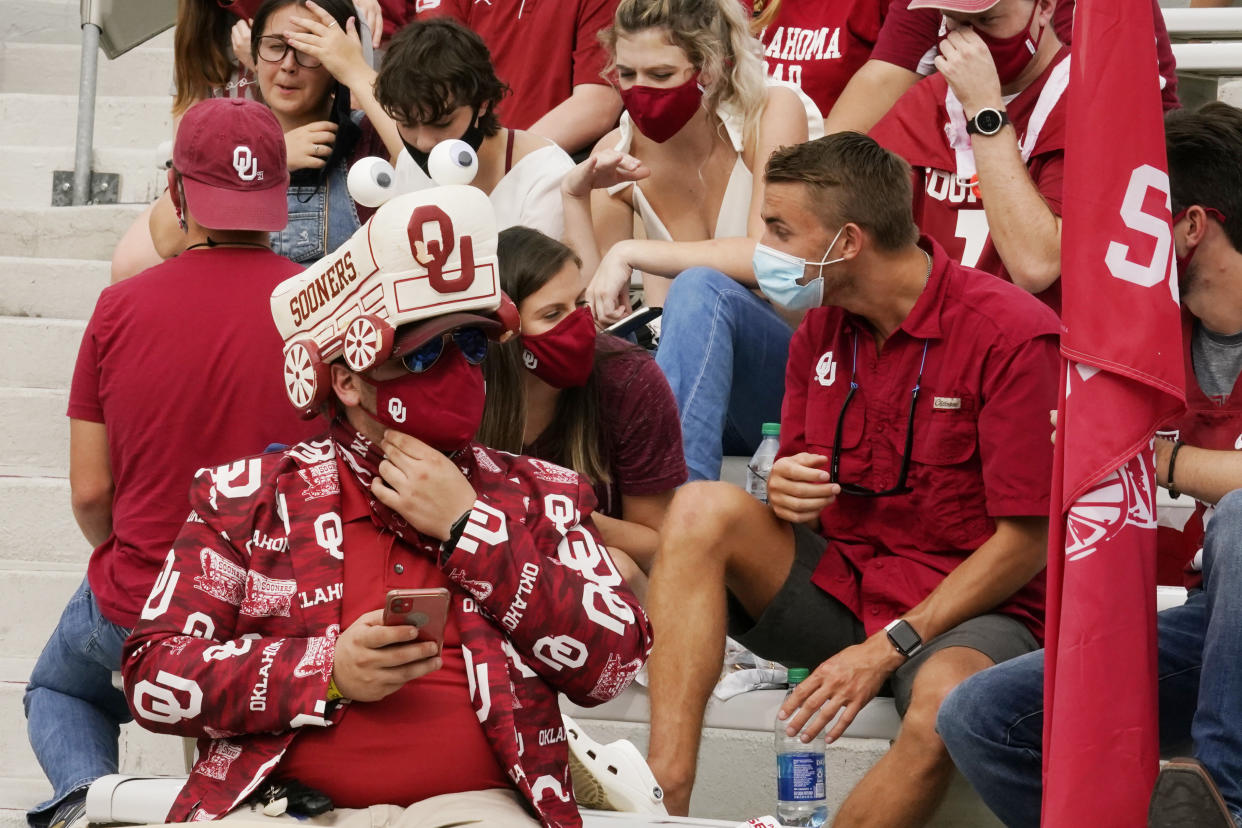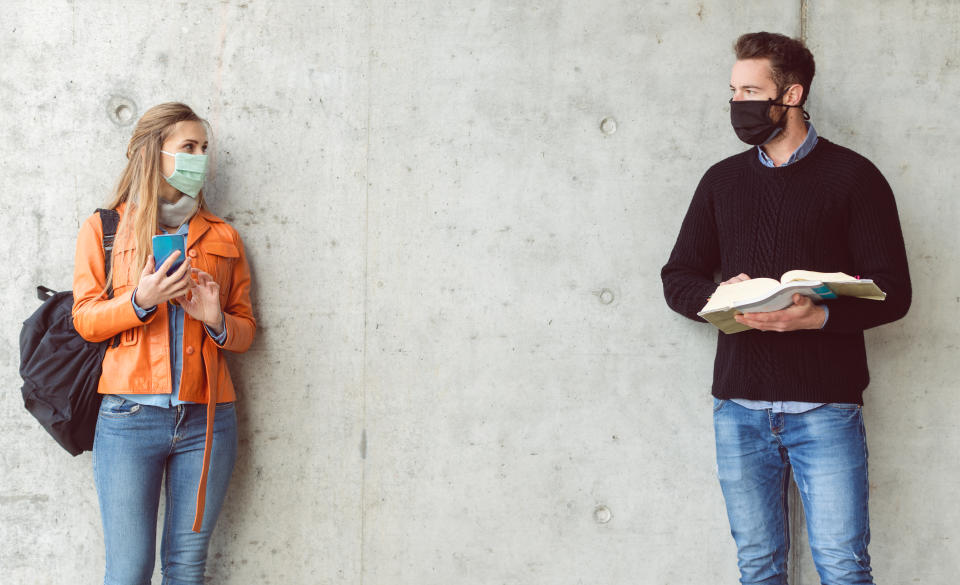Why COVID outbreaks on college campuses due to risky behavior were predictable: 'Many young people end up feeling that risks do not apply to them'

The school year is just getting started, but coronavirus cases have already been reported at colleges and universities in all 50 states.
More than 40,000 coronavirus infections have been reported among students, faculty and staff at colleges and universities across the country, according to CNN estimates.
Despite the risks, some college students continue to gather in groups and attend parties without social distancing or wearing masks — even, as with some Miami University students, despite knowing they are infected with coronavirus.
Experts say this risky behavior in the face of a global pandemic isn’t surprising — and part of that can be chalked up to the fact that adolescent brains are still developing.
“It was believed that adolescence ended at 18,” says Yahoo Life mental health contributor Dr. Jen Hartstein of Hartstein Psychological Services in New York. “We now know that it begins at puberty and ends in the mid-20s. Part of adolescent development is the learning of self-regulation skills. Most young people in college do not have these yet, so they tend to be more impulsive, not considering the risks and just [acting] without thinking it all through.”
Jill M. Emanuele, PhD, the senior director of the Mood Disorders Center at the Child Mind Institute, explains to Yahoo Life that, biologically, there’s a difference between adult and teen brains because adolescent brains are still maturing well into their 20s.
“The part of the brain that helps [teens] organize, plan and think ahead — the prefrontal cortex — is key in this,” Hartstein tells Yahoo Life. “As it is not fully developed, many young people end up feeling that risks do not apply to them, so they just keep moving forward without thinking about what might happen. As they begin to see the cause and effect of things more clearly, their behaviors might change.”
But in general, college students take more risks, says Emanuele, thinking, “‘Hey, this isn’t going to happen to me,’” she says. “There’s this sense of invincibility. ‘I just want to have my life back.’”
Barbara Greenberg, PhD, a clinical psychologist who specializes in the treatment of adolescents, agrees, saying: “They feel immortal.”
There’s also a strong desire for teens to be with their peers. “Many of these teens have been in quarantine for many months and want to get back to a sense of normalcy and are really struggling with that,” says Emanuele. “They are willing to take the risks to do that.”
Greenberg explains that’s because adolescents “weigh the positives more heavily than the negatives.” She adds: “It’s not that they don’t see the negatives — they do — it’s that the positives of being with friends weighs more heavily” than the risks of getting COVID-19.
Teens have an “intense” need to socialize and be with friends, says Greenberg, “and are very afraid of peer disapproval. They want more than anything else to fit in. When you have a group of teens, they make decisions that they wouldn't necessarily make as an individual. A teen who would wear a mask when alone may not necessarily wear a mask in a group” if others aren’t.
Adding to the challenge is that teens and their parents have gotten mixed information about how adolescents are impacted by the virus, notes Hartstein. “Some may think that they are invincible, as there is an element of that for young people, and others may hold on to the belief that they won’t get it because of their age. So, it’s a mixed bag.”
While younger people tend to have more mild to moderate COVID-19 symptoms, and those 17 and under have a lower risk of hospitalization and death from the disease, some can develop serious infections — and experts are still trying to understand the long-term health effects of the virus.
How to help your teen make safer choices
Experts say there are a few ways that adults can reach teens to help encourage them to make safer choices.
If your teen is still living at home, model the behavior you want to see, suggests Hartstein, such as wearing a mask, washing hands frequently and social distancing. “The good part about developing brains is that it’s possible to have influence over them,” she says. “If you model the behavior you expect to see, they are more likely to follow it.”
Also, communicate with them openly and honestly. “Talk with them about how they are feeling, what they understand ... especially as it relates to the coronavirus,” says Hartstein. “Maybe they don’t understand some things or are holding on to old information.”

Greenberg says it’s important to convey that kids are getting sick. “The rates of kids getting sick have gone up,” she says. “They have to know their peers are getting sick. Show them articles so they can be aware. You don’t need to terrify them — you need to educate them.”
But don’t make it a lecture. “You [also] want to listen to your teen’s perspective,” says Emanuele, “so there’s some sort of collaborative discussion going on. ‘How can you see your friends safely?’ ‘What’s a risk and what’s not a risk?’ ‘If you see this person and you get sick and bring this back, everyone is going to get sick. Do you understand that?’”
Since banning them from seeing any of their friends is likely unrealistic, especially if they’re away at college, discuss with your teen how to safely spend time with a couple of close friends — namely, meeting friends outdoors while social distancing and wearing masks. “Use the outdoors as much as possible in safe numbers [to] at least get some socialization,” suggests Greenberg.
Above all, says Hartstein, keep the communication going: “Repetition is key. Seeing the pros and cons of behaviors is important. Understanding consequences is helpful. Keeping the conversation going helps young people to learn and understand what is needed during this weird and challenging time.”
For the latest coronavirus news and updates, follow along at https://news.yahoo.com/coronavirus. According to experts, people over 60 and those who are immunocompromised continue to be the most at risk. If you have questions, please reference the CDC’s and WHO’s resource guides.
How to maintain your physical and mental health during the pandemic
Taking care of a loved one with COVID-19? Here’s how to stay healthy
Q&A with Dr. Kavita Patel: How to keep your family safe and maintain your mental health
Read more from Yahoo Life:
How outdoor classrooms might — and might not — be the pandemic solution schools need
Sending your kids back to the classroom? Here's how experts advise keeping them safe.
How remote learning is revealing a digital divide: 'Not all students have equitable access'
Want lifestyle and wellness news delivered to your inbox? Sign up here for Yahoo Life’s newsletter



